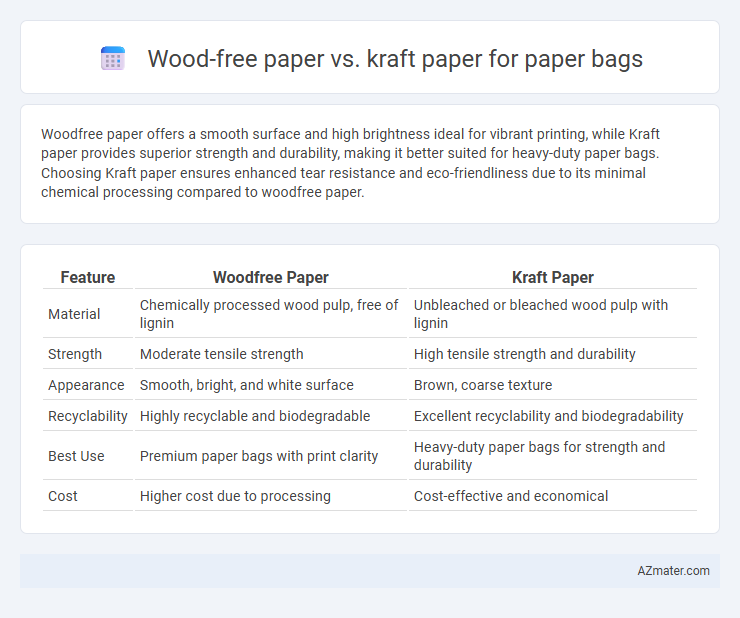Woodfree paper offers a smooth surface and high brightness ideal for vibrant printing, while Kraft paper provides superior strength and durability, making it better suited for heavy-duty paper bags. Choosing Kraft paper ensures enhanced tear resistance and eco-friendliness due to its minimal chemical processing compared to woodfree paper.
Table of Comparison
| Feature | Woodfree Paper | Kraft Paper |
|---|---|---|
| Material | Chemically processed wood pulp, free of lignin | Unbleached or bleached wood pulp with lignin |
| Strength | Moderate tensile strength | High tensile strength and durability |
| Appearance | Smooth, bright, and white surface | Brown, coarse texture |
| Recyclability | Highly recyclable and biodegradable | Excellent recyclability and biodegradability |
| Best Use | Premium paper bags with print clarity | Heavy-duty paper bags for strength and durability |
| Cost | Higher cost due to processing | Cost-effective and economical |
Introduction to Paper Bag Materials
Woodfree paper used in paper bags is primarily composed of chemical pulp with most lignin removed, offering a smooth surface ideal for high-quality printing and a clean aesthetic. Kraft paper, made from strong chemical pulp fibers, provides superior durability and tear resistance, making it suitable for heavy-duty packaging and reusable bags. Both materials are favored for eco-friendly paper bags, but Kraft paper's robustness often makes it the preferred choice for carrying heavier loads.
What is Woodfree Paper?
Woodfree paper, commonly used in paper bag production, is made from chemical pulp with lignin removed, resulting in a smooth, high-quality surface ideal for printing and packaging. Unlike kraft paper, which retains lignin and offers superior strength and durability, woodfree paper provides a cleaner appearance and better color reproduction but is less resistant to moisture and tearing. Its refined texture makes woodfree paper preferable for lightweight, aesthetically focused bags rather than heavy-duty applications.
What is Kraft Paper?
Kraft paper is a strong, unbleached paper made from wood pulp using the Kraft process, which retains most of the lignin, giving it high durability and tear resistance, ideal for heavy-duty paper bags. Unlike woodfree paper, which is chemically treated to remove lignin and appears smoother and brighter, Kraft paper maintains a coarse texture and natural brown color, enhancing its eco-friendly appeal. Its superior strength and biodegradability make Kraft paper the preferred choice for sustainable, reusable paper bags in packaging industries.
Key Differences Between Woodfree and Kraft Paper
Woodfree paper, made from chemical pulp with minimal lignin content, offers a smooth surface and high brightness, making it ideal for printing quality and aesthetic appeal in paper bags. Kraft paper, produced through the kraft process using wood chips, is valued for its strength, durability, and resistance to tearing, making it suitable for heavy-duty and eco-friendly paper bags. Key differences include woodfree paper's superior printability versus kraft paper's enhanced toughness and environmental sustainability.
Strength and Durability Comparison
Kraft paper offers superior strength and durability compared to woodfree paper due to its unbleached fibers and higher tear resistance, making it ideal for heavy-duty paper bags. Woodfree paper, typically made from chemical pulp with minimal lignin, has a smoother surface but lacks the tensile strength and moisture resistance found in kraft paper. For applications requiring robust carrying capacity and longevity, kraft paper remains the preferred choice in paper bag manufacturing.
Print Quality and Appearance
Woodfree paper offers superior print quality and a smooth, bright surface ideal for high-resolution images and vibrant colors on paper bags. Kraft paper provides a natural, rustic appearance with a coarser texture, resulting in a more subdued print finish that enhances eco-friendly branding. The choice depends on whether the priority is sharp, detailed graphics or a rugged, organic look for the paper bag.
Environmental Impact: Woodfree vs. Kraft
Kraft paper offers superior environmental benefits for paper bags due to its biodegradable and recyclable properties, stemming from minimal chemical processing of wood pulp. Woodfree paper, while exhibiting a smoother finish, typically involves extensive chemical treatments that increase environmental pollution and reduce biodegradability. Consequently, Kraft paper's sustainable production and natural fibers make it the preferred choice for eco-friendly paper bag manufacturing.
Cost Considerations
Woodfree paper generally incurs higher production costs due to its chemical pulping process, resulting in smoother, brighter paper suitable for premium paper bags. Kraft paper, made from mechanical pulping of wood fibers, offers a more cost-effective option with higher durability, making it popular for heavy-duty or bulk paper bags. Businesses prioritizing budget efficiency typically prefer Kraft paper for paper bags to minimize material expenses without sacrificing strength.
Ideal Uses for Woodfree Paper Bags
Woodfree paper bags are ideal for retail packaging, gift bags, and high-quality shopping bags due to their smooth surface and excellent printability, which allows vibrant graphics and branding. They are preferred for lightweight products and applications requiring a clean, professional appearance without the need for heavy-duty strength. Their chlorine-free production process makes them a sustainable choice for eco-conscious businesses seeking attractive, recyclable packaging solutions.
Ideal Uses for Kraft Paper Bags
Kraft paper bags are ideal for heavy-duty packaging due to their strength, durability, and resistance to tearing, making them perfect for groceries, retail products, and food packaging. Woodfree paper, with its smoother finish and higher brightness, is better suited for high-quality printing and lightweight applications like gift bags and boutique packaging. Kraft paper's natural, eco-friendly composition and superior moisture resistance make it the preferred choice for sustainable, reusable paper bags that require robust performance.

Infographic: Woodfree paper vs Kraft paper for Paper bag
 azmater.com
azmater.com